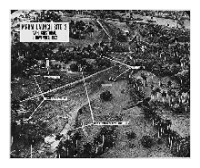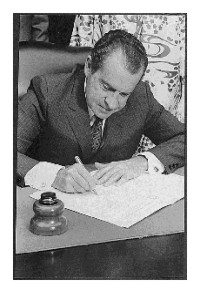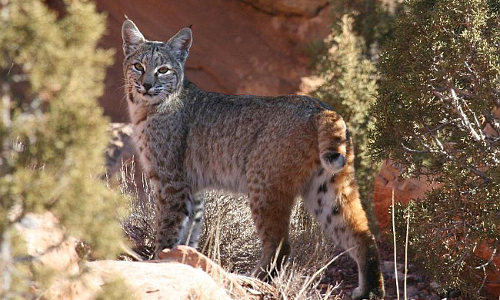Sponsor this page. Your banner or text ad can fill the space above.
Click here to Sponsor the page and how to reserve your ad.
-
Timeline
1964 - Detail
January 9, 1964 - The Panama Canal incident occurs when Panamanian mobs engage United States troops, leading to the death of twenty-one Panama citizens and four U.S. troops.

Article by Jason Donovan
For centuries, the act of moving goods, cargo, and people from the Atlantic
to the Pacific or vice versa required ships to sail around the tip of South America,
known as Cape Horn. This journey took roughly twenty-seven days, give or take,
and was an extremely perilous voyage that has claimed many lives over the
years. The idea that there must be a quicker, safer way to travel between oceans had long been debated.
A canal through Panama was settled on in the early twentieth century. The
United States was involved with the project, after the French project failed. The area around the canal is called
the canal zone. The U.S.'s involvement in controlling the canal created tension
between the native Panamanians and the Americans living in the zone, known as
Zonians. The tensions between Panamanians, Zonians, and successive U.S.
administrations would simmer for years. This tension finally boiled over,
resulting in the deadly uprising of 9 January 1964, known in Panama as "Martyr's Day."
The canal's history arguably begins in 1903 with the signing of the Hay-Bunau-Varilla Treaty by President Theodore Roosevelt. Following the signing of
this treaty, tensions arose due to the lingering effects of its terms. The treaty
gave Americans the bulk of the benefits. The effect of this arrangement established a two-tiered system, with the Zonians, backed entirely by the
American government, being the first class. At the same time, the native
Panamanians were the underclass, thus getting the scraps of the canals' benefits.
The situation was put into clear terms when Ashley Byrne, in her article entitled
"50 years ago this week, riots determined the fate of the Panama Canal," when
she quoted Jose Ponse, who gave a firsthand account of what it was like for the
Panamanians living around the canal zone when he stated, ...
"There was an apartheid that existed in the colonial atmosphere of the zone. You
had the segregation of a group of workers mainly from the Antilles — Afro
descendants that were completely segregated."
National pride was also at play in this instance. Panamanians are a proud people, as they should be. Panama's national
interest was not taken seriously over the years. They were basically just
speaking into the wind. When a nation's pride and say in their own country is
taken from them, a small situation turns into a ticking time bomb.
Tensions over the flying of the Panamanian flag were not new, according to
a CIA briefing dated 10 January 1964, which states that violence had broken out
in 1959 due to an issue with the flag. With pressure, once again, growing over the
flying of the Panamanian flag in the Canal Zone, the Canal Zone Governor, Major
General Robert J. Fleming Jr., had, in an attempt to defuse the situation, selected
seventeen locations where both the American and Panamanian flags would fly
side by side. As part of this decision, no flags would be allowed outside the chosen
locations. As has happened multiple times in world history, a small group from
the colonial occupiers does something foolish and not well thought out.

Provocation
The group in this particular case was a group of American high school
students from a high school in Balboa, located within the zone, who, in direct
defiance of the governor's order, raised the American flag in front of their school.
This act was a provocation that would not go unanswered. One hundred and fifty students from a local Panamanian high school
marched in protest while carrying their national emblem. The students left after being told to disperse and go home. In a direct quote from a 17 January
1964 article in Time, ...
"U.S. officials, "there was no more trouble than you'd expect at a Yale-Princeton
football game."
The students' march was just a moment of calm waters before the hurricane.
An event during the students' march would set off the powder keg. During
a scuffle between the two groups of students, the Panamanian flag was torn. The
Panamanians would not take any more. Even a tire has a pressure limit.
Years of discrimination and anger boiled over into violent and deadly
actions. The main disturbances were in Panama City and Colon. In Panama City,
by 6:30 pm, hundreds of people had gathered after word of the flag-tearing
spreading as fast as the winds of a category five hurricane, as the crowd grew
along the length of the canal zone border, attempting to enter the zone in order to
plant their flag. As the crowd grew even larger, the officials within the canal zone made
multiple attempts to contact the Guardia Nacional of Panama, but received no
response.
With no backup forthcoming, the police force of the Balboa district made
up of no more than eighty men had to cover the nearly two-kilometer-long border.
At first, the police used tear gas in an attempt to control the crowd. With the
stocks of tear gas running low, guns were deployed. With the situation continuing
to escalate and crowds growing, acting Governor Of The Zone
Lieutenant Governor Colonel David Parker contacted the commander of United
States forces, General Andrew P. O'Meara, Commander in Chief of the Army's
Southern Command, for reinforcements, advising him he was about to be overrun.
O'Meara approved sending troops to contain what had now turned into a full
scale uprising.
The Riot
The Panamanians had started to stop cars, flipping them over and setting
them on fire. The crowds started attacking the train station and a laundry,
attempting to destroy both. A small force of police conducted a holding operation
as the nearby residential area was evacuated. Using tear gas, the small group
began to move the crowd back. The commanding officer ordered his men to fire
over or in front of the crowd. Some rounds went into the crowd, killing a twenty-
year-old student at the National Institute named Ascanio Arosamena, becoming
one of the first deaths.
At the same time, in other areas along the border, more cars were burned and rocks were launched into more residential areas. A crowd tore down a fence
and began advancing on a district judge's house, using Molotov cocktails to light
it on fire. The areas mentioned above and the violence described were not the
most violent.
The central area of the border was the area of the most violent activity; the
areas of the Legislative Palace and the Pan American Building in Panama, and
the Hotel Tivoli in the Canal Zone. At this part of the border, the violence started
in the early evening while there was still a fair amount of traffic in the streets.
Rocks were thrown at passing cars, and traffic lights were torn down. With
the word of violence spreading, the normal evening traffic seemed to evaporate.
As the evening continued, the crowd of thousands congregated around the Pan
American Building. As in the other parts of the border, cars were burned, and
traffic lights continued to be torn down. The difference in this area was that
windows were smashed, and doors were broken before looting commenced, continuing through the night. The situation escalated when the Pan American
Building was set on fire, burning through the night. The fire was
the cause of a great tragedy, as six people were trapped in the burning building.
By around 8:30 to 9:00, the army had reinforced the police and took control
of the zone. Later in the evening, the troops around the Hotel Tivoli began to
come under sniper fire, mainly from the Pan American Building and the
Legislative Palace. With their rules of engagement not to use firearms, shots were
not returned at first. As the fire intensified, these orders were changed to allow
the use of shotguns with birdshot directed towards the Panamanian side.
As a result of the incoming bullets and after O'Meara attempted to contact his
Panamanian counterparts with no success, he ordered a sergeant to take a group
of men to the hotel with more powerful weapons to eliminate the snipers firing on
his forces. These men started their task on the early morning of the tenth. The
firefight lasted for roughly two to three hours. When it was all said and done, the
Panamanians had fired roughly 465 rounds at the hotel, and 400-500 rounds
came from the canal zone side. Ten U.S. servicemen were injured, along
with, based on local hospital records, 95 Panamanians, eighteen of
them being fatal. The true number could not be determined by an investigation
committee set up by the U.S. government.
There were also possible situations in which Panamanians had fired on
each other, as well as shop owners firing in an attempt to curtail the ongoing
looting. These actions all started on the ninth and tenth of January. While there
were more attempts by some groups to enter the zone, the situation as a whole
was much calmer over the next few days, with the Guardia Nacional finally
assembling on the thirteenth. Panama City was not the only city to experience
violence. An uprising also occurred on the Atlantic side of the canal in the city of
Colon.

Riots in Colon
Colon is a smaller city, but when the fury of a wronged population explodes,
the city's size does not matter. With radio reports of the uprising in Panama City
being broadcast over the radio waves, it was not long before unrest started in the
city. At the beginning of the night, a crowd of 1,000-1,500 people had gathered in
the Cristobal area, which is a terminal port adjoining the city. The
crowd made its way to the Panama Canal Administration Building within the
Cristobal. This demonstration was mostly peaceful, with the Mayor of Colon
present in the crowd. The crowd insisted on raising their flag on the building's
flagpole. Their flag was raised, and the crowd sang the Panamanian national anthem, which was then taken down by the Panamanians themselves. It is
essential to recognize the work of the Canal Zone authorities, which included the
chief of police, who showed restraint and with persuasion was able to defuse the
situation. As such, the crowd returned to the city. This demonstration was only
tarnished by a few groups smashing car windows.
Less than an hour later, another demonstration was held, containing
several thousand people. The demonstration made its way into the canal zone
between the Masonic Temple and the old Commissary. The police chief of the
Cristobal had come back out to meet this larger demonstration and appeared to
be defusing the situation again. A second group of protestors started to raise the
violence level as they began throwing projectiles at the Y.M.C.A. and Masonic
Temple, resulting in broken windows. With the situation getting rapidly out of
control, the police requested that the army provide backup. Violence and death
were going to follow.
Around 10:30 pm, the army was in control of the Cristobal in the area of
the temple, Y.M.C.A., and the old Commissary. When the army was deployed, it
was in battle uniform and helmets, with guns held forward with fixed bayonets. The soldiers advanced toward the assembled crowd that had come from the Colon
side. Captain Howard tried in vain to convince the people to disperse and go
home. Instead, the group broke away from the main body and continued to
advance into the Cristobal. This smaller group was met by army soldiers who
attempted to, via a show of force, get the group and the crowd in general to
move back and to have them disperse. The show of force may have had the
opposite effect, as the Panamanians started to scuffle with the soldiers as they
attempted to grab the guns and bayonets. The crowd became more and more
excited. A combination of these actions and the crowd winding up a spasm of
violence resulted in the area of the Temple and Y.M.C.A. experiencing extensive
damage to the two buildings, plus looting.
Within fifteen minutes, the crowd had been pushed back across the border
as the officer in command posted men who sealed off the canal zone. The crowd
was once again, shortly before midnight, involved in a violent shooting and
wounding of a U.S. soldier. A U.S. soldier would, shortly after midnight, be killed
by a shot originating from across the border. The wounding and death of these
troops were due in part to the lack of any type of armor. The troops moved back
to the areas around the Temple, Y.M.C.A., and old Commissary to prevent further
casualties. The violence continued.
The next day, the tenth, two more troops would die and nine more would
suffer wounds from the shots; these casualties now came from inside the
canal zone. Violence continued throughout the course of the night. By
midmorning, Molotov cocktails were used against the Y.M.C.A. building, which
would burn to the ground. By noon of the next day, the old Commissary would
suffer the same fate.
The situation would continue with the troops being authorized to use
shotguns to subdue fire from the Panamanian side of the border. The order to use
the shotguns came as a result of three soldiers being killed and twelve being left
wounded. Even though these deaths are tragic, a six-month-old infant succumbed to injuries caused by the use of tear gas earlier in the evening. The death would
continue when a jeep from Guardia Nacional came under sniper fire while the
jeep was tangled in barbed wire in the darkened street as they were driving in the direction of the harbor. The gunfire caused the death of a
sergeant and wounded another occupant in the jeep. A phone call from the
Guardia was taken by the Colonel in charge of U.S. forces, in which he agreed that
his men would not fire on the forthcoming ambulance. The ambulance would
come under fire, but the source of this fire is not fully known. The entire situation
could have been worse overall.
As a result of the violence, the army set up a checkpoint over a bridge into
the canal zone. All traffic was forbidden, but foot traffic was allowed, and persons
with weapons were turned back. Those with a reasonable reason to be in the zone
were allowed to pass. There were more checkpoints on the road connecting
Panama City and Colon, the Colon Corridor or the Bolivar Highway; these were
checkpoints that were manned by Panamanians.
Aftermath of the Riots
The Guardian Nacional would take over checkpoints between 11 and 13
January. By 13 January, the situation was under control as the Guardia Nacional
moved the Panamanians back and patrolled the border.
With the Cold War in full swing and the combatants of said war looking for
any advantages they could, the violence of those days in January of 1964 was a
flashpoint of that war. A CIA briefing advised that it was believed that Communist
elements from Cuba and the Soviet Union were working to aid in the incitement
of violence. Panama was just another flashpoint on a long and bloody path that
made up the hot portion of the Cold War.
In Panama, 9 January is observed every year for those that died over
those few days of violent release of built-up rage that pushed a marginalized
populous in their own land and triggered by one more of millions of insults
leveled against them with the expectation that, like all the times before, the
Panamanians would just take it. This was a foolish assumption in an incident that
was triggered by the acts of Zonian teens with the same colonial
imperialist foolishness that United States administrations had held over the
region. The deadly situation was no laughing matter, but it was largely due to the
nonsense that ultimately stemmed from a culture of hubris within the Canal
Zone, which extended all the way up to the President of the United States.
It was this culture that would lead to the deaths during this incident. The
history of this event can be a teaching moment, as it shows how not to treat a
nation that may not be as strong as another. Dignity must always be part of any
arrangement, and or, during the activities of the above arrangement. A lack of
respect was at the center of the actions of Martyr's Day. The dead and injured of
that day are a lasting example of what results from such situations. May their
pain, suffering, and death serve as a poignant warning, a warning the world
would be wise to heed. May those who gave their lives rest in peace.
Photo above: Panamanians students raising their flags near the Gorgas hospital, 1964, Panama Canal Commission. Courtesy Wikipedia Commons. Photo below: Montage (left) Maj. Gen. Robert J. Fleming, Jr., Canal Zone Governor, 1967, U.S. Army; (right) Commander Andrew Pick O'Meara, U.S. Army. Courtesy Wikipedia Commons. Info source:







